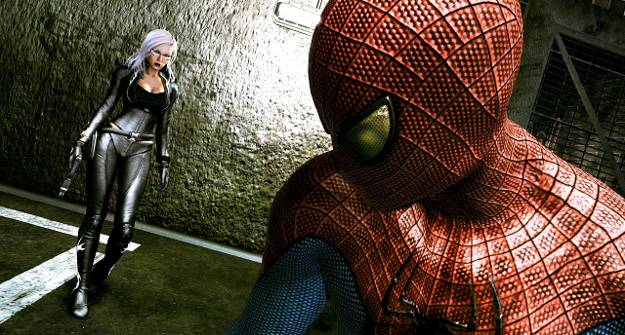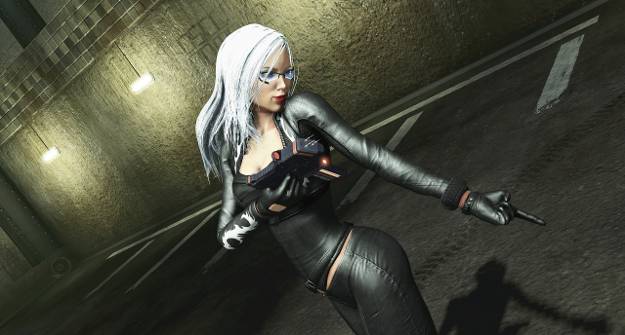Recently, I read somewhere that suggested the mark of a good superhero game is that it leaves you feeling...well, like a superhero. I don't think this is something anyone would dispute. I mean, what made both Arkham games great is that they left you feeling like Batman as you skulked about in the shadows, striking fear into criminals' hearts. The best Incredible Hulk games work because they turn you into a rampaging green rage monster and let you destroy everything in your path. Conversely, video game versions of Iron Man, Aquaman and Superman all failed because – in addition to being clunky, buggy pieces of garbage – they did a lousy job of capturing the essences of their characters.
Both of Beenox's two most recent Spider-Man games, Shattered Dimensions and Edge of Time, fell somewhere in the middle. The former was a little closer to the good end of the spectrum, with its multiple Spider-men and different styles of gameplay, while the latter was significantly less enjoyable, with a pair of indistinguishable Spider-men and seemingly endless time spent crawling through tunnels. Ultimately, though, with their extremely linear stories and game worlds, you never really got to experience what it was like to be your Friendly Neighbourhood Spider-Man.

The Amazing Spider-Man corrects this problem, and then some. Yes, there's a story mode -- one that's loosely associated with the film of the same name (the game takes place shortly after the events of the movie) -- but the real allure of the game is that you've got a wide open sandbox of New York City to play in. You can swing down busy Manhattan streets, zip from rooftop to rooftop, dive at the ground from the tops of very tall buildings, and never once are you forced to go anywhere to make the story keep moving.
In fact, Beenox seems to have made the game with exploration in mind, filling the city up with all kinds of side missions. The game's New York City is full of muggers to fend off, escaping bank robbers to chase down, photos to take, and sick people to rush to medical care, among other things. Even when you've cleared the city of all these things and popped their respective Trophies/Achievements, there are still 700 comic book pages to hunt down -- most of which can only be found by wandering through the streets and soaring through the sky. Sure, they're just collectibles that have little bearing on your character once you've maxed out all your upgrades, but at the same time, it gives you something to do for hours after you've completed the game, should you feel the urge to just swing around the city.
It's a mark of how smoothly The Amazing Spider-Man runs --particularly compared to the last two Spider-Man games -- that such urges wouldn't be unreasonable. The way this Spider-Man swings, and soars, and zips, and fights; in all these respects, the game does a great job of making all your movements flow naturally, and in leaving you feeling like your movements are flowing naturally.
It should be no surprise, then, that the game falters a little when it takes this freedom of movement away from you. When you're pushed inside, and you lose all that open space, I'm not going to lie: the game becomes less enjoyable.

Considering the vast majority of The Amazing Spider-Man's story takes place indoors, I can see this being enough to turn some people off the game. Heck, if I'm being honest, after the game's first two chapters gave me nothing but linear paths to go down, I was almost ready to give up on it. If there's one thing I learned from Spider-Man: Edge of Time, it's that crawling down endless tunnels, vents and air ducts doesn't make for a very fun gameplay experience. It's something I wasn't eager to repeat.
That said, on the upside, Beenox did what they could to minimize the pain of the indoor sections. They borrowed some of the stealth elements from the Spider-Man Noir sections of Shattered Dimensions (which means, by extension, they stole them from the Arkham games' detective modes), allowing you to lurk in the shadows and on ceilings as you wait to take down some of the more heavily-armed baddies. Additionally, they made the environments a little more interactive, which made the fights a little more fun (if a little illogical when you think about it -- I mean, why would bad guys keep so many helium tanks and cabinets just lying around, waiting to be thrown?). You still have to contend with the occasional tedium of crawling in a straight line, but, unlike in past games, you aren't left feeling like that's all you did.
And besides, as far as I'm concerned, no matter how sick you may get of those sections, it's nothing a little free-roaming web-slinging won't cure -- and thankfully, that's something The Amazing Spider-Man has in spades. It's not quite on the level of Arkham City, but it's miles better than either of Beenox's last two efforts, which means that if you're in the mood for a good superhero game, then this will absolutely do the trick.